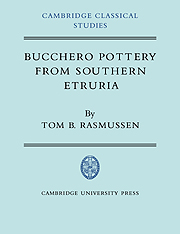Summary
The earliest bucchero of Cerveteri by far surpasses in quality all pottery previously produced in Central Italy, and indeed in the whole W. Mediterranean area. The production of the thin-walled bucchero of GROUPS 1–3 required careful preparation of the clay, skilled control of firing, and great precision at the wheel. In excellence of technique, as well as in other aspects, favourable comparisons may be made with Protocorinthian pottery. Is it possible that these technical improvements may be due to the presence of immigrant Corinthians at work in Cerveteri workshops? The influence from Corinth can, however, be overstated. In the typological analyses at attempt has been made to trace, where possible, the earlier history of specific types in impasto. By this means one can see bucchero emerging from an earlier native tradition – early bucchero evolving as a gradual refinement of impasto shapes and technique. Moreover the decorative styles and techniques belong for the most part to this same native tradition, with some taken from native metalware. Of the Protocorinthian shapes copied by the earliest bucchero only the kotyle attains real popularity, whereas among purely native shapes there are the amphora Type 1a, jug Type 1a and kyathos Types 1a-c. There is also an Oriental element, which we see most clearly in the oinochoe Type 2a and in the style of the earliest incised animal friezes. It is later – after the middle of the seventh century – that Protocorinthian influence becomes really dominant with the appearance of the olpe, oinochoe Type 3a, cup Type 1c and the later incised friezes.
- Type
- Chapter
- Information
- Bucchero Pottery from Southern Etruria , pp. 157 - 159Publisher: Cambridge University PressPrint publication year: 1979



